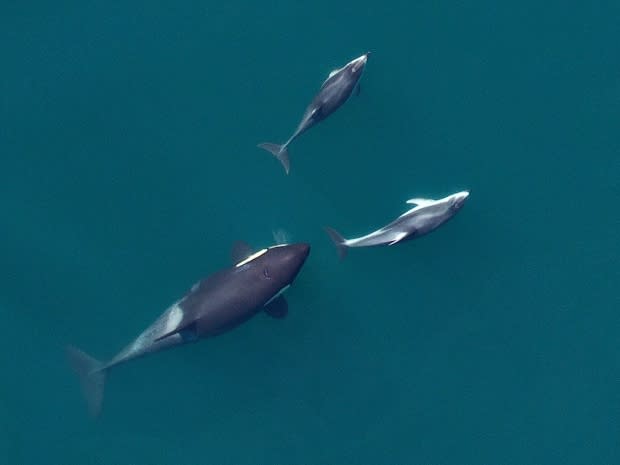Killer whales eat dolphins. So why are these dolphins tempting fate?
Killer whales are the only predators that regularly kill and devour Pacific white-sided dolphins off the B.C. and Washington coasts. So researchers were surprised when drone footage showed such dolphins playing within a few fin-spans of killer whales' toothy jaws.
"The dolphins are right in front of the killer whales, right in front of their mouths," said Lance Barrett-Lennard, senior scientist and director of the marine mammal research program at the Coastal Ocean Research Institute. "This kind of association between one species and its apparent predator is unusual."
It turns out the dolphins have nothing to fear from these particular killer whales, also known as orcas.
Southern resident killer whales are nearly physically identical to, very genetically similar to, and officially the same species as dolphin-eating Bigg's killer whales that roam the same waters.
But it just so happens that southern resident killer whales are strict pescatarians that avoid all red meat, although they eat fish.
Somehow, the dolphins can tell the difference. But Barrett-Lennard thinks they're still being pretty bold.
"It's pretty risky for a marine mammal to approach a killer whale in the hopes that it's approaching a fish eater. The two forms of killer whale look very, very similar to us," he said. "These dolphins seem to have absolute confidence around the fish eaters and would get eaten immediately if they were around the mammal eaters."
Watch killer whales and dolphins swim together:
Researchers aren't sure how the dolphins tell the difference, but they think it's based on the sounds the whales make. Southern resident killer whales are much chattier than their Bigg's cousins, making frequent calls to one another and relying heavily on echolocation while fishing.
That still leaves the question of why the dolphins would be so eager to hang out with these orcas, even if it were perfectly safe. Researchers have witnessed dolphins charging over from a kilometre away to join the killer whales after noticing them, and then hanging around for sometimes weeks at a time.
They suspect the dolphins may actually be protecting themselves from Bigg's killer whales. Bigg's killer whales and southern resident killer whales take great pains to avoid each other — "in such a conspicuous way that you might imagine there must be a reinforcement of their conflict occasionally," Barrett-Lennard said.
From that perspective, the dolphins are safer when they're with the southern resident killer whales. But Barrett-Lennard acknowledges it's difficult to know if the dolphins are aware of that.
The researchers suggest that the dolphins might also be trying to learn more about killer whales in general in order to better avoid the dolphin-eating kind.
One-way relationship?
Barrett-Lennard doesn't think there's any benefit for the orcas. In fact, they don't tend to seek out dolphins and appear to avoid them if they see too many at once, by going silent and staying submerged, he noted.
Ken Balcomb, director of the Center for Whale Research in Friday Harbor, Wash., said researchers there have also seen Pacific white-sided dolphins swimming with southern resident killer whales on rare occasions.
"It usually looks quite amicable, but occasionally when the dolphins buzz in the faces of the whales, the whales seem annoyed," he said in an email.

Barrett-Lennard said while it might be unexpected to see dolphins hanging out with orcas, it's not at all unusual to see dolphins hanging out with other dolphin and whale species.
"They're not xenophobic … they're attracted to other species in general, and this is an extreme case of that."
They're also not the only killer whale prey species seen hanging out with killer whales. Researchers have seen Dall's porpoises with killer whales, including one that "even started to swim a bit like killer whales," Barrett-Lennard recalled. "It'd sort of rise with its head out of the water and then do this funny diving motion that was very killer-whale-like."
His team shot the footage of the dolphins and killer whales while conducting unrelated research funded by the Vancouver Aquarium's Ocean Wise program in collaboration with the U.S. National Oceanic and Atmospheric Administration.
The drones have been used since 2014 to study northern and southern resident killer whales off B.C. and Washington state. One of the goals of the program is to monitor how southern resident killer whales fare and how skinny they get in years when chinook and chum salmon, their preferred prey, are scarce.

